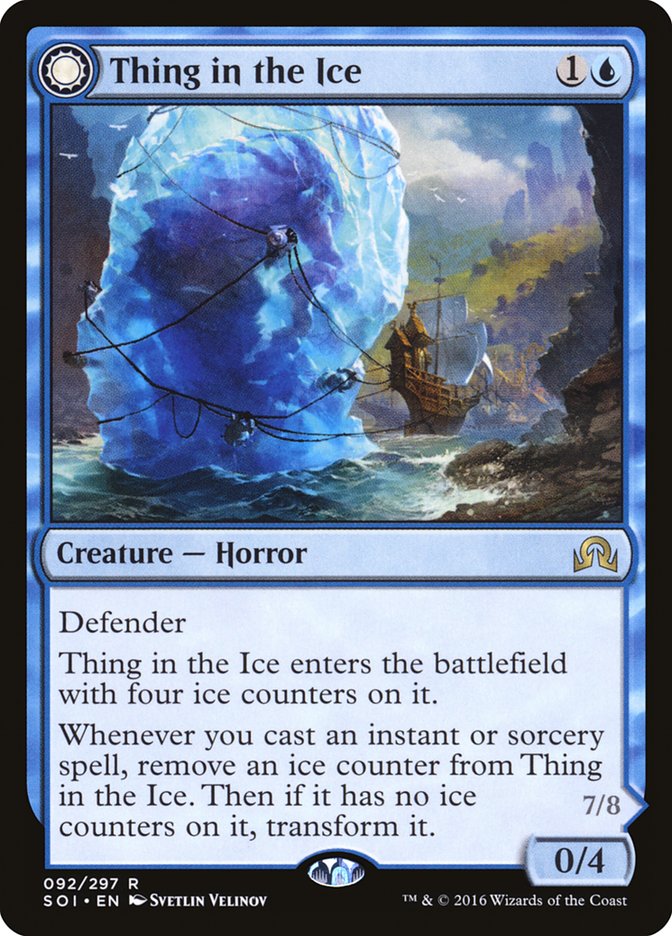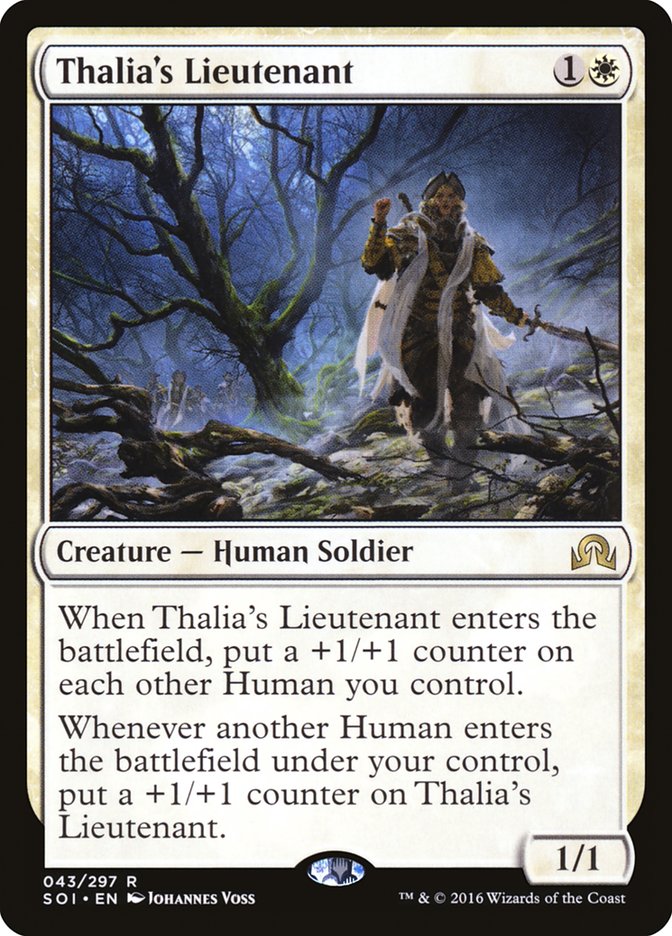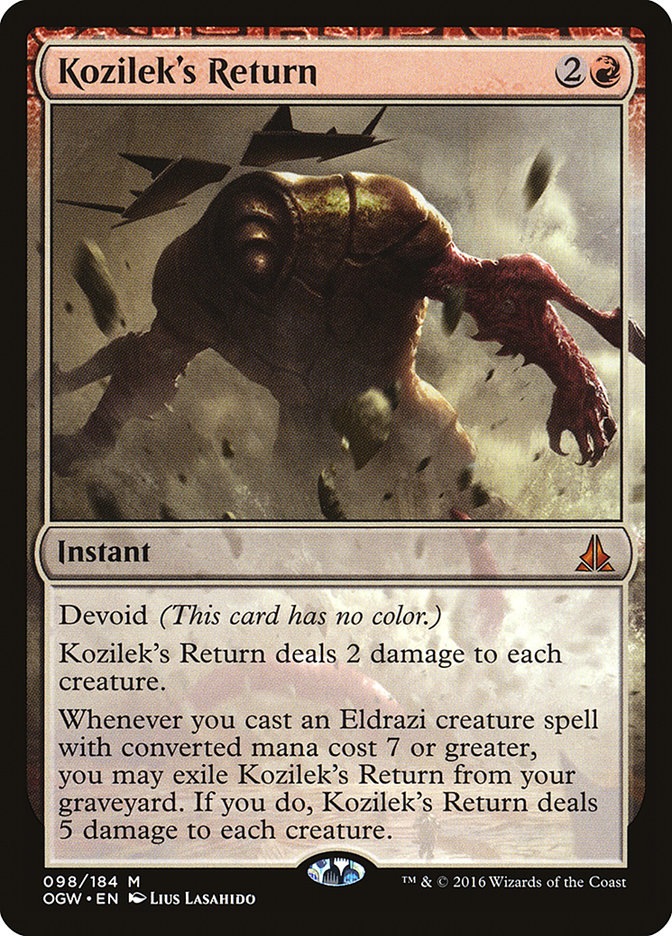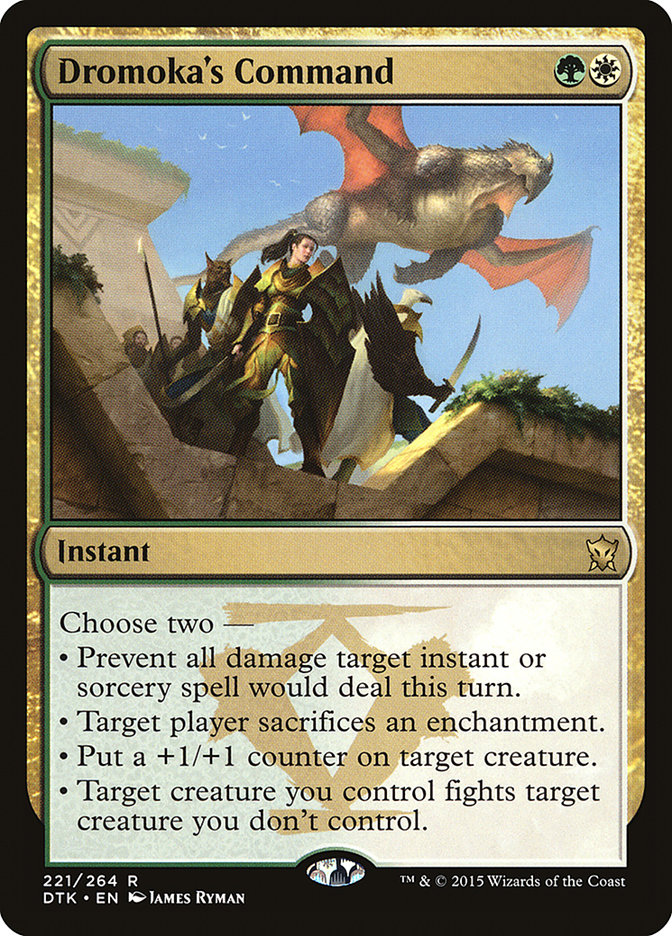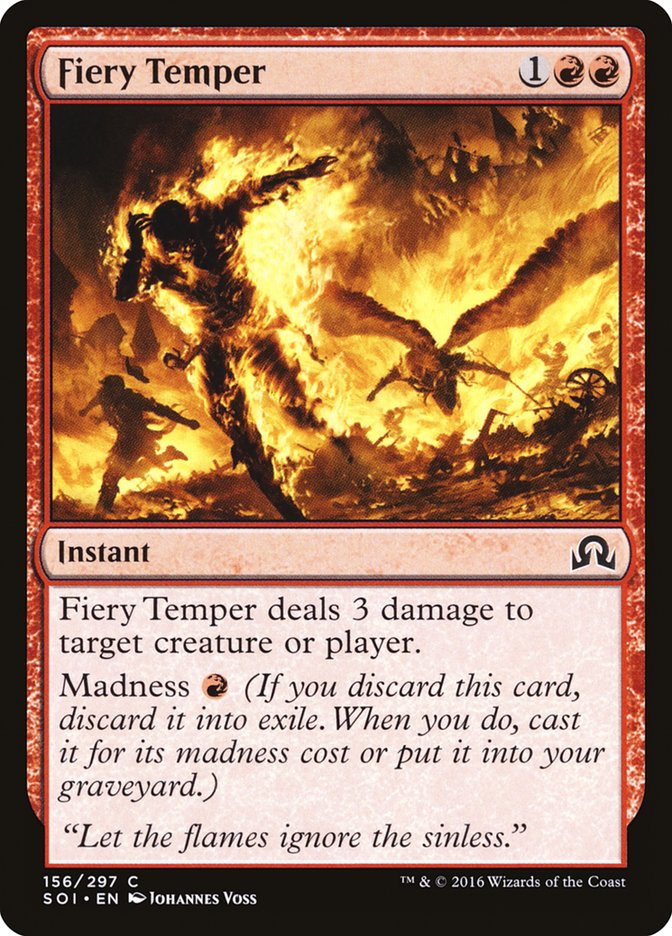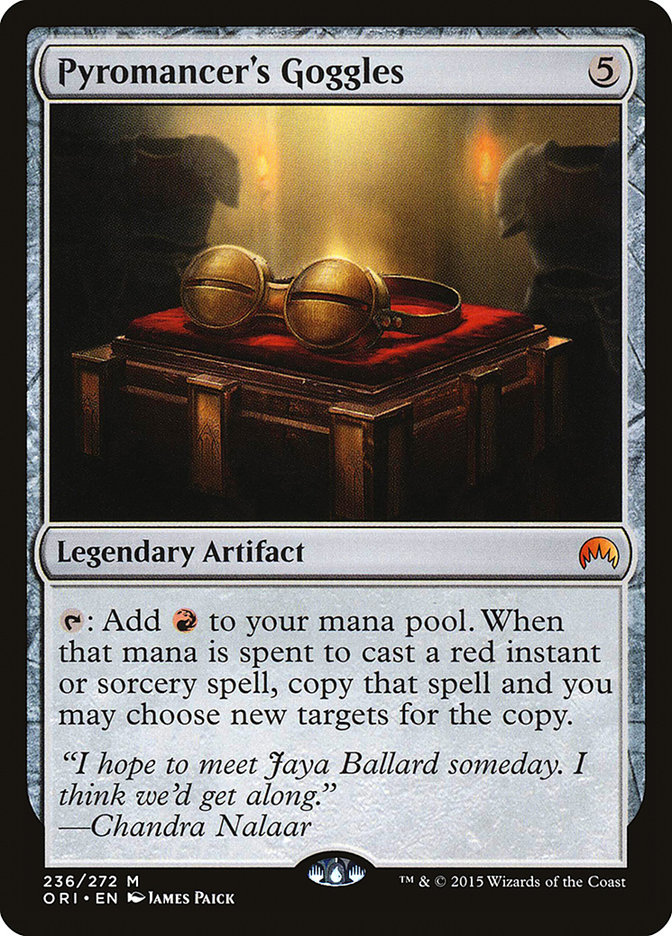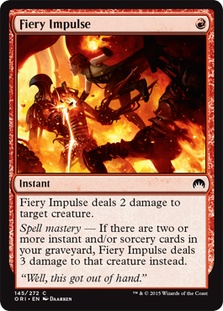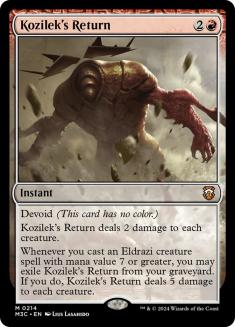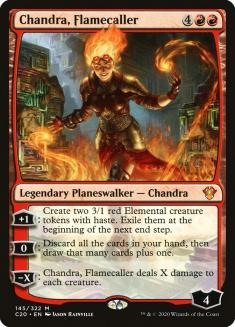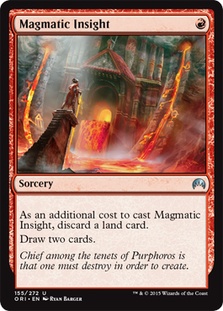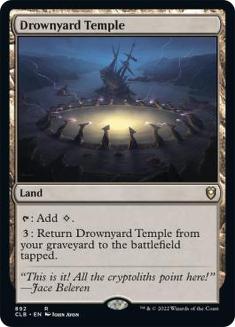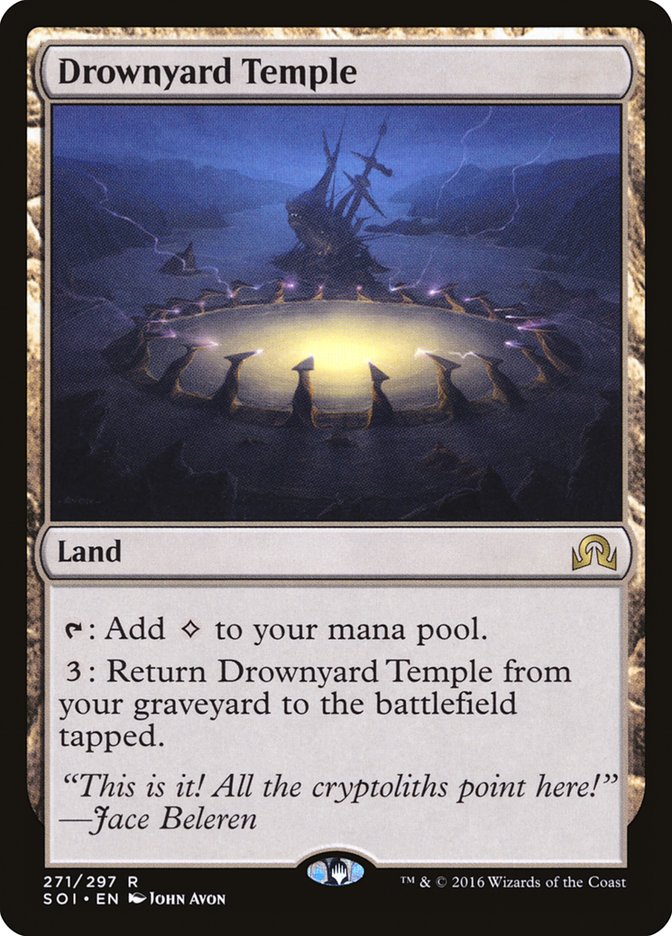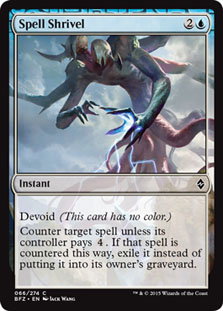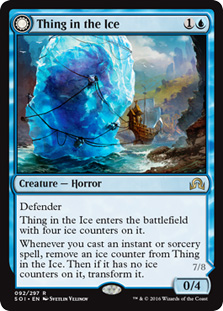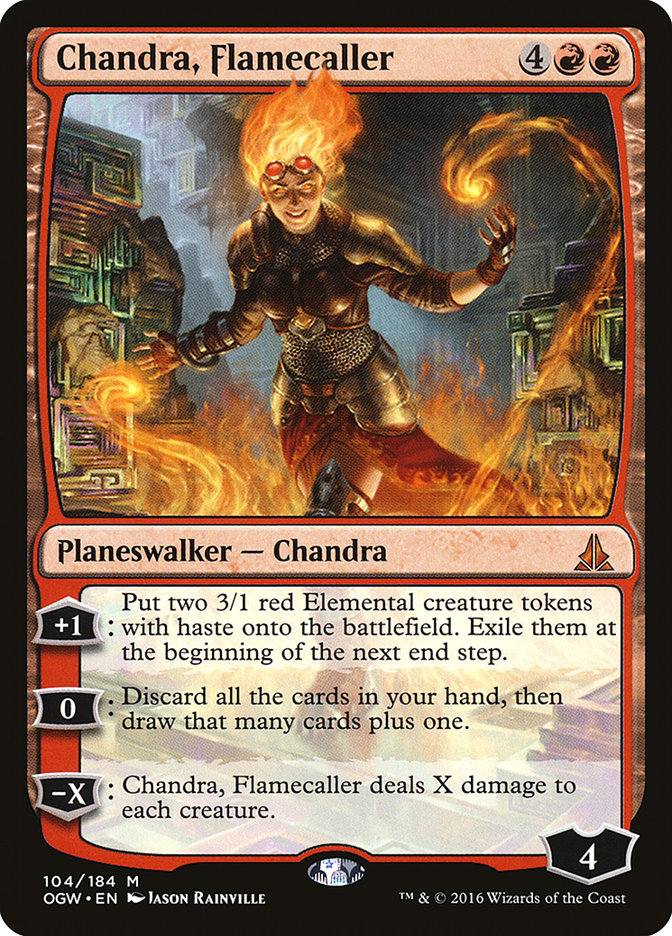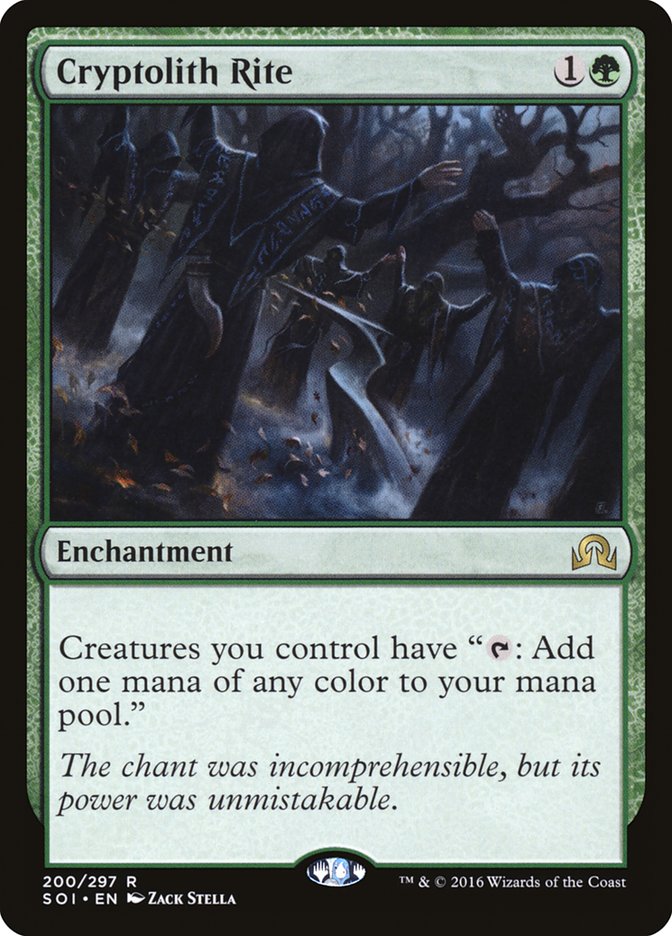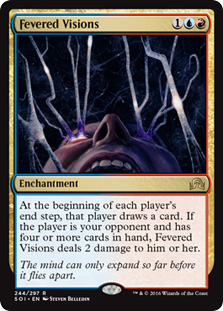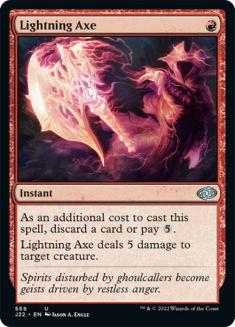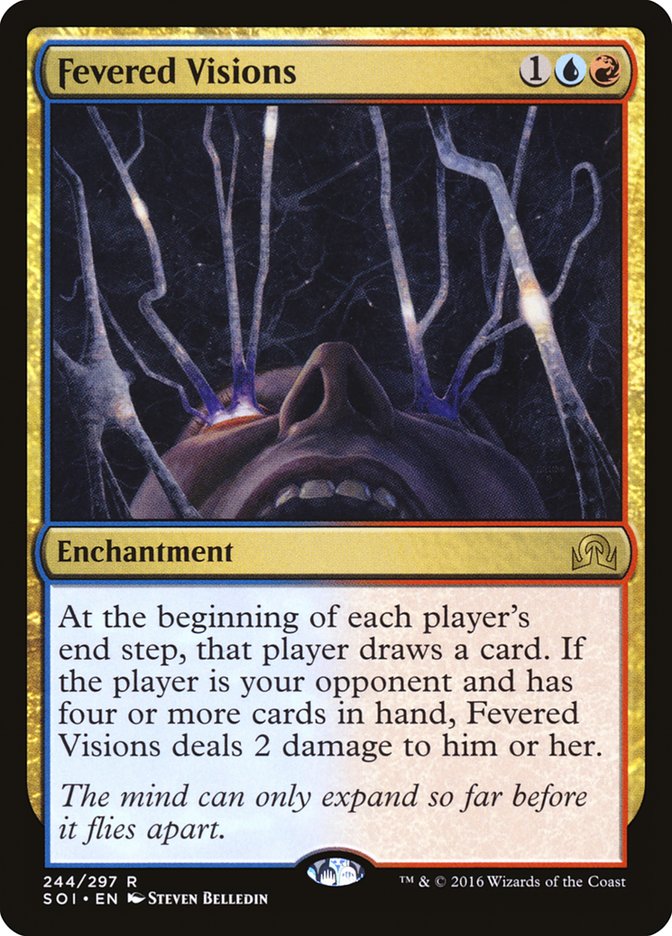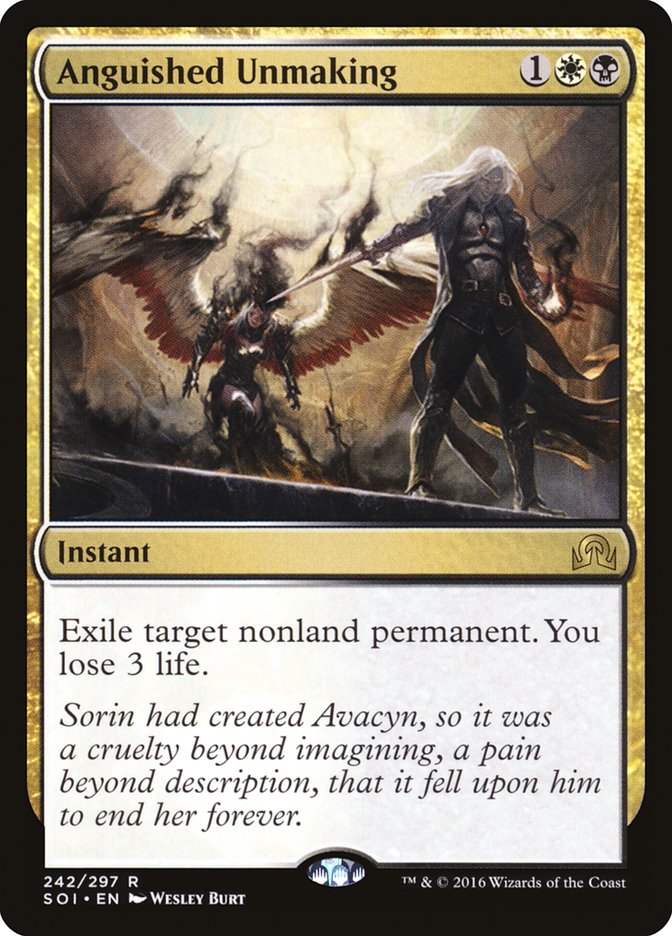If you have been paying attention to the most recent results in Standard, you might be seeing a trend. Creature-based decks are at an all-time high, ranging from hyper-aggressive to midrange, but even the control decks are sporting a good number of targets for removal-based decks. But the other thing I noticed is that people aren’t playing a lot of good removal spells for Thing in the Ice. And that gets my juices flowing.
Of course, you don’t have to believe me when I tell you Thing in the Ice was pretty great in the first few weeks of Shadows over Innistrad Standard. But it was, even though it quickly became weaker and weaker. Reflector Mage can be a kick in the teeth, but other than dedicated control decks playing a ton of black removal, most of the other decks in the format are reliant on Dromoka’s Command or a scant few copies of Declaration in Stone to remove it. After the first few weeks of Standard, it became clear that Thing in the Ice was pretty mediocre in a field full of Silkwrap, Reflector Mage, Stasis Snare, and all the B/G Seasons Past decks, but times have changed.
Todd Stevens’s Bant Humans and Tom Ross’s W/R Humans are both fairly aggressive strategies that aren’t exactly versatile. Other than the raw card advantage gained by Collected Company, you can usually beat them by killing their creatures on a one-for-one basis as long as you have a big cleanup card to close out the game. Obviously, that can be tough to do against a deck that plays a ton of one-mana creatures, like W/R Humans, but a single Kozilek’s Return or even Avacyn’s Judgment can be devastating. Of course, the game can go on long enough that those removal spells can become irrelevant, thanks to Always Watching, but you are generally favored in the long game. After all, zero copies of Gideon, Ally of Zendikar in the maindeck gives you a lot of breathing room.
While Todd Stevens’s Bant Humans deck goes a little bit bigger and can potentially invalidate some of the weaker removal out of a red-based deck, it tends to be a bit slower than most other aggressive strategies. But it can also play Magic forever. With so many Clues generated by Tireless Tracker and Thraben Inspector, you will have to grind through them for a while. That is yet another reason why Thing in the Ice could end up being phenomenal against this particular subset of decks. You need a closer, and you need it to have a big effect on the game early on.
The draw of Thing in the Ice at the beginning of the format is exactly what’s drawing me back to it now. Two mana is such a small investment on a card that could potentially get shut down, and especially so when it can just block and prevent damage in the early stages of the game. Sure, they use Dromoka’s Command on it after combat damage…so what? That’s a Dromoka’s Command they aren’t using to counter your Lightning Axe or Fiery Temper, and they didn’t put another threat onto the battlefield. It’s a win-win situation.
If you haven’t been able to guess by now, I’m talking about U/R Goggles. Yeah, I know, nothing new to see here, right? Well, if you realized how little we actually got to explore the archetype before it fell off the map, you’d understand that it is very likely we missed something. For how strong the deck felt at the time I played it, I can’t imagine it is just “bad.” It is much more likely that the deck just needed to evolve.
“Well, Todd, what about the G/R Goggles deck that Brad Nelson smashed with at the Pro Tour? Isn’t that an evolution of the Goggles strategy?”
Creatures (4)
Planeswalkers (2)
Lands (24)
Spells (30)

You could be right, but that was a different deck. Sure, it had a lot of the same engine pieces, but the removal suite and top-end spells were significantly different. At that tournament, the Flashback ability on Kozilek’s Return was necessary to combat the overwhelming strength of Bant Company, a deck that has since fallen to the wayside in favor of other (similar) decks that do things a bit differently. World Breaker and Nissa’s Pilgrimage were the only green cards in the maindeck, but having to play so many Forests for Nissa’s Pilgrimage made the deck play pretty awkwardly at times.
As far as I could tell, Pyromancer’s Goggles wasn’t actually that good in the deck. It was just another part of the ramp strategy, but that was very much a ramp deck.
With U/R Goggles, the Goggles are the main plan. We don’t have a lot of other ways to actually win the game, so we build our deck to utilize Pyromancer’s Goggles. That means more red spells and a better manabase, which is key for a deck like this. In the past, I’ve played various strategies like G/R Valakut featuring Primeval Titan, which was basically a mono-green deck that was forced to play ten or more Mountains to support Valakut, the Molten Pinnacle. There were…problems, to say the least. And I think G/R Goggles suffered the same fate, but without a similar power level.
If we’re moving forward and looking at the current format to deduce the best possible version of Pyromancer’s Goggles, I’m still leaning towards the U/R version. In a nutshell, the G/W Tokens matchup is a bit difficult at times, but it can be beaten, and Thing in the Ice goes a long way in helping us beat it. And since they’re adding more creatures and cutting a few of the trickier cards to play around (like Secure the Wastes), our objective is a bit clearer.
But G/W Tokens is only a fraction of the current metagame, and the rest of the format is soft to a deck full of removal spells and card advantage.
Creatures (8)
Planeswalkers (2)
Lands (26)
Spells (24)

Since I’ve written about a lot of the theory behind the deck already, today we’re going with a no-nonsense plan of helping you beat all the major decks in the format. I’ll give you a sideboarding guide as well as a short description on the types of things that matter in each matchup. So let’s get started with public enemy #1, thanks to The Boss.
Creatures (31)
- 4 Knight of the White Orchid
- 4 Dragon Hunter
- 3 Kytheon, Hero of Akros
- 2 Anointer of Champions
- 2 Consul's Lieutenant
- 4 Expedition Envoy
- 4 Thraben Inspector
- 4 Thalia's Lieutenant
- 4 Town Gossipmonger
Lands (18)
Spells (11)
Sideboard

In:
Out:
In this matchup, their deck is far too fast to rely on Magmatic Insight to get us any traction with Drownyard Temple. We expect the games to go a bit longer than we’d like, which means we need to shave on a land. And since we’re cutting Magmatic Insight, I think it is more than reasonable to trim a Drownyard Temple.
Our plan of attack here is simple: kill everything. We’re also trying to flip Jace, Vryn’s Prodigy or Thing in the Ice, but those are secondary (for the most part). Thing in the Ice is definitely solid against them, but not the end of the road. Most of their creatures are cheap, but it is a nice way to put pressure on them and buy you a turn of reprieve.
I know it may seem strange to cut a land and bring in a six-drop, but Chandra, Flamecaller is one of the best cards you can have in the matchup since they don’t have a lot to do at instant speed. A Chandra that can minus and wipe the battlefield clean while staying alive will be a Chandra that lives to see the next turn.
I would plan to mulligan most hands that don’t have early interaction. You need some way to kill their creatures, and a hand full of lands and creatures of your own won’t get the job done. One tough thing about the matchup to recognize is that you don’t have infinite time. Once they land an Always Watching or two, many of your removal spells will be invalid without Pyromancer’s Goggles. They don’t play that many lands, so they will rarely flood out, so finding a way to close the game is important.
Creatures (26)
- 4 Reflector Mage
- 3 Eldrazi Displacer
- 3 Thraben Inspector
- 4 Thalia's Lieutenant
- 4 Tireless Tracker
- 4 Lambholt Pacifist
- 4 Duskwatch Recruiter
Lands (25)
Spells (9)

One of the biggest decks of the weekend, Bant Humans can pose problems for U/R Goggles if they get out of hand. Luckily, you have a ton of removal to slow them down, and your card drawing engine is a bit more fluid than theirs. Unfortunately, Reflector Mage can be pretty good against us if we’re too reliant on Thing in the Ice. My advice, in a nutshell, is to do your best to not rely on it flipping. After sideboard, I might make it a habit to cut Thing in the Ice against all Reflector Mage decks.
In:
Out:
Unfortunately for us, the sweeper in our deck is not very good against this deck. Few of the creatures in the Bant Humans deck are susceptible to the two damage from Kozilek’s Return and even those can be pushed above two toughness quite easily. Thing in the Ice, as already discussed, can be a bit mediocre against any creature-based strategy that involves Collected Company and Reflector Mage, which is what pushed me away from Thing in the Ice to begin with.
But Thing in the Ice is serviceable in the first game and will likely persuade the opponent to bring in more removal like Declaration in Stone to deal with it. Fewer creatures in our deck will put a lot of pressure on Jace, meaning it won’t flip too often, but drawing one or two copies of Jace as a cheap distraction is fine. If you want to lessen the effect of Reflector Mage leaving a second copy of that creature stuck in your hand, you could also potentially sideboard out two copies of Jace instead of two copies of Thing in the Ice.
The Bant Humans deck is powerful and can grind through a gameplan that involves a lot of removal, which is why you need to find one of your engine cards once you’ve stabilized. Pyromancer’s Goggles drawing some cards or killing two creatures at a time is a big deal, as it will push you ahead without much effort. But you’ll need to find either Chandra, Flamecaller or Fall of the Titans to end the game before they get to pop all their Clues and draw into more pressure.
Spell Shrivel isn’t particularly good in this matchup, but their deck is slower than most aggressive decks. On the play, it should be exceptional. On the draw, it could get awkward, so don’t be afraid to discard it to a Tormenting Voice.
Creatures (14)
Planeswalkers (8)
Lands (26)
Spells (12)

The proverbial elephant in the room, G/W Tokens is one of the toughest decks to play against, both in terms of strength of individual cards as well as threat variation. Planeswalkers and cheap creatures combine to make life hell for most control decks, as you need your answers to directly line up with the spells they are casting.
And that’s one of the beautiful aspects of playing a deck like G/W Tokens. Your opponent is under pressure to answer everything you do. If they don’t, it doesn’t take too long for Gideon, Ally of Zendikar to get out of hand. On the other side of the coin, this deck doesn’t play well from behind, so if you’re able to stabilize and start your Pyromancer’s Goggles engine, it will be tough for them to dig back out of that hole.
In:
Out:
I will start by saying that this particular version, as opposed to those that play Secure the Wastes and/or Lambholt Pacifist, is a bit tougher to sideboard against. If your opponent has Secure the Wastes, you should leave in Kozilek’s Return. If your opponent has Lambholt Pacifist, you should leave in Fiery Impulse. Each version can be tricky, which is why it is important to know the reasons behind sideboarding as opposed to a cookie-cutter in-and-out plan.
If you think they’re more aggressive, consider trimming or cutting Magmatic Insight. You might not have time to cast it, and you want to hit most of your land drops. Obviously, this takes away some of the synergy in the deck, as you want to use Magmatic Insight with Drownyard Temple when you can, but you need to assess what they’re doing before you can figure out what you should do. This is another reason why this deck is so tough to play against. One or two card changes from them can alter the dynamic of the match.
We’re a bit more reliant on Thing in the Ice than I’d like, especially in the first game, but you need a way to clear the battlefield and attack their planeswalkers. Wandering Fumarole plus a removal spell can occasionally take care of a Gideon, Ally of Zendikar, but that gets harder when they have Hangarback Walker.
This might be the toughest matchup, which is a hard pill to swallow since it has done so well in recent weeks, but I think it can be beaten given a good draw and a knowledge of the matchup. When they are on the play, it can feel impossible for any deck to beat Sylvan Advocate into Nissa, Voice of Zendikar into Gideon, Ally of Zendikar, no matter what deck you’re playing. Luckily, that draw doesn’t happen too often, and you can usually leverage your removal and card advantage to get a small edge.
After sideboarding, we have a number of ways to attack their planeswalkers thanks to Negate and Spell Shrivel, but those aren’t the only targets. Stopping a timely Dromoka’s Command or Archangel Avacyn can be just as important. It all depends on their draw and what you deem as important in helping you gain control of the game.
Creatures (27)
- 3 Elvish Visionary
- 1 Nissa, Vastwood Seer
- 4 Eldrazi Skyspawner
- 4 Reflector Mage
- 4 Eldrazi Displacer
- 3 Reality Smasher
- 4 Sylvan Advocate
- 4 Duskwatch Recruiter
Lands (25)
Spells (8)

While they’re no longer running the combo featuring Brood Monitor and Zulaport Cutthroat, this deck is still a beast. They are marginally vulnerable to Kozilek’s Return as well as spot removal, but Reality Smasher can extraordinarily tough to deal with. After sideboarding, Thought-Knot Seer poses a similar problem but is slightly more manageable. Thing in the Ice is not particularly great in the matchup, as it suffers from a vulnerability to both Reflector Mage and Eldrazi Displacer, but is again serviceable in the first game.
In:
Out:
There are arguments to be made for bringing in Spell Shrivel to help contain the bigger Eldrazi, but that would require cutting some of the more important pieces of the deck. Jace, Vryn’s Prodigy was great in the matchup, but that could be different now that the Brood Monitor package has been replaced by Reality Smasher.
I know I side out Thing in the Ice a lot and side in Chandra, Flamecaller in nearly every matchup, but this is another one of those “for the sake of the curve” arguments. In the first game, you have a distinct plan that involves a lot of moving pieces. You can’t always rely on Tormenting Voice to discard extra uncastable cards. We’re already heavy on Pyromancer’s Goggles, and you need a lean curve to interact with a lot of these decks.
There is also a bit of inherent value to having Thing in the Ice in the first game. Your opponent will have to respect it and bring in cards that make it significantly worse. If you no longer have it in your deck, well, that leaves a lot of mostly dead cards in your opponent’s deck. Better players may discover that it is unnecessary to bring in extra removal, but then you can just flip the script on them when you get to the third game. I make a lot of radical sideboarding choices with the deck because it is inherently flexible (which is why I love the deck in the first place).
As for this matchup in particular, it is likely best to lower your vulnerability to Reflector Mage, which means cutting a card that might actually be decent in the matchup. Bouncing their battlefield is pretty good, and especially so with Cryptolith Rite since all of their creatures have summoning sickness, but you have to look at the bigger picture. Matches are best of three for a reason, so having your deck built in such a way the first game could alter how they sideboard for the next two. This can give you an advantage, but you also need to make sure you don’t trick yourself. It is a thin rope to walk.
Planeswalkers (8)
Lands (26)
Spells (26)

This is quite possibly my favorite matchup to play against, mostly because I get to implement the Fevered Visions plan. The cards I sideboard in vary slightly, so this isn’t one-for-one.
In:
Out:
While Owen Turtenwald’s version doesn’t play a lot of creature cards in the maindeck, Kozilek’s Return is still fine against Secure the Wastes as a way to make sure you don’t lose to Westvale Abbey. For the most part, your Fiery Tempers should keep their Shambling Vents in check, but can also be used to snipe planeswalkers alongside the two damage from Fevered Visions. It is also a way to close the game by burning out your opponent with Pyromancer’s Goggles.
These games will generally go pretty long with you both trading resources constantly, but you have a few trumps. Pyromancer’s Goggles is particularly tough for them to beat once it resolves, as their only way to do it will be Anguished Unmaking. Granted, they will be hitting you with a flurry of discard effects, but that can be overcome via Fevered Visions. The reason why we cut all of our creatures is that we want Fevered Visions to do a lot of the heavy lifting. By taking out all of our creatures, we leave them with a lot of dead cards stranded in hand. This means they’re flooded with resources by Fevered Visions without a way to utilize those extra resources.
I think most people will have their own spin on the deck, like Archangel Avacyn or possibly Knight of the White Orchid, but they are also bottlenecked into sideboarding in a lot of creatures to try to kill you. If they’re privy to your plan of siding out all your creatures, once again you can flip the script for the third game and bring them back in. A Jace, Vryn’s Prodigy or Thing in the Ice can be devastating if they don’t have an answer, but from my experience that is never the case.
Your goal here is to kill anything and everything they play, but try to save your counterspells for planeswalkers. If they’re able to stick a Gideon, Ally of Zendikar or something when you’re not ready for it, the game can end on the spot. However, if you’re able to stick an early Fevered Visions, most of what they do no longer matters. They’re under pressure, and they have very few ways to stop it. Just use your burn spells in a smart way and you should be able to take the game from them in a few turns. Your deck operates much better with an extra card per turn than theirs.
…
I understand that I may be blinded by my love for Pyromancer’s Goggles. I also understand that many have told me before that the deck I liked in Standard was bad. I can’t recall the number of times Brad Nelson tried to convince me to play anything except Jeskai Black. While Standard seems to be flush with viable archetypes, many of them are too similar and too battlefield-heavy for me to want to pick up and jam.
I think I could play Collected Company, but is it really worth it if it makes me unhappy? I’ve been struggling lately with trying to make the winning choice versus the thing I like doing. Deck selection is very important in tournament Magic, but I’ve found that I tend to do better when I take one archetype, stick with it, and mutate it from week to week, trying to fight whatever people think the “best deck” is. In actuality, there is never a best deck. It’s all contextual, because the best deck almost always has a natural predator, and there are weeks where playing the predator to the “best deck” is actually playing the “best deck.”
It’s convoluted and stupid, and just words people say to sound smart (including myself). So find your U/R Goggles, whatever it may be, and try sticking with that instead of hopping on whatever deck is “best” from week to week. I’ve seen what that does to people, and I’ve seen them struggle with tournaments and have no idea why. Well, maybe the reason is because you aren’t skilled with that archetype, or you didn’t predict how that deck winning the most recent tournament would affect the metagame.
So if you’re a brave soul and like to kill creatures and loot with Jace, Vryn’s Prodigy, give U/R Goggles another spin. You might just have some fun.


